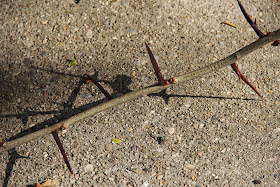I have a tree in my backyard that has taken physical defense to an extreme level.
 |
| Honey Locust thorns |
Those long three-pronged thorns belong to a Honey Locust (Gleditsia triacanthos). The Honey Locust is a deciduous tree that native to the central United States from the west slope of the Appalachians westward to a line running from central Texas north to central Kansas and eastern Nebraska. It ranges south to the Gulf Coast and north as far as Minnesota and Wisconsin. In Michigan it is native only to the southern tier of counties. The Honey Locust can grow to heights of 80 feet and commonly lives 120 to 150 years. It has compound leaves and as a member of the Bean Family (Fabaceae) it produces long seed pods with large seeds.
 |
| Honey Locust seed pod and leaves |
The Honey Locust developed its impressive thorns to deter herbivores from browsing its leaves and branches. This seems like a sensible approach, many other species have developed similar defenses (roses, raspberries, prickly ash, etc.). Let's take a closer look at those thorns to see if they would be a good defense.
 |
| Honey Locust branch with leaves removed to show thorns |
The thorns are certainly impressive and would seem to be enough to deter the average herbivore, but lets add a ruler for scale.
 |
| Honey Locust branch with 12-inch rule for scale |
Those thorns seem to rather far apart to deter an herbivore like a White-tailed Deer (Odocoileus virginianus). The thorns spiral around the branch and are all at least three inches apart. The distance between any two thorns on the same side of branch may be greater than eight inches. It would not be too difficult for a deer to avoid. Also the length of the thorns seems a little more than is needed to deter a deer. Many of the thorns are over 4 inches long!
 |
| This Honey Locust thorn measures more than four inches long! |
Just for fun here is picture of one of the thorns with my hand for scale. I have repeatedly stepped on fallen limbs in my yard and stuck those small thorns in the soles of my shoes. I definitely do not want to close my hand around them.
 |
| A Honey Locust thorn in hand |
So these thorns are a little big to be defense against herbivores like White-tailed Deer. Just what is the Honey Locust trying to protect itself against?
The Honey Locust, like most plants, has a long memory. A very long memory. While each individual tree might only reach an age of 150 years, the memory of the species goes back much further. When the tree species was developing those thorns there were much larger herbivores walking around North America.
How much larger?
How about the size of an elephant?
 |
| Mural depicting American Mastodons (Mammut americanum) - Museum of Natural and Cultural History at Central Michigan University |
So would the long thorns have been effective at defending the Honey Locust from Mastodons and other large herbivores? We can assume that Mastodons (and mammoths) fed much like their modern relatives the African and Indian Elephant. Elephants use their trunks to gather vegetation either from the ground or from trees and then use massive molars to grind the vegetation. The large thorns of the Honey Locust may have deterred the Mastodon from using its trunk to strip leaves and branches from the tree.
 |
| Fossil American Mastodon Jaw -Museum of Cultural and Natural History at Central Michigan University |
 |
| Close-up of fossil Mastodon molar |
If the mastodon did manage to remove the branches from the tree without injuring its trunk, would the thorns have prevented the animal from chewing the branches? Let's take a closer look at one of the mastodon's molars.
 |
| Replica mastodon molar |
Just how big are these teeth?
 |
| American Mastodon molar (replica) - measures 8 inches long |
 |
| American Mastodon molar (replica) - 4 inches wide |
 |
| Honey Locust branch and American Mastodon molar (replica) |
Its thorns might be over-sized for any herbivorous threat it will encounter today, but the Honey Locust is unconcerned. It took thousands of years to develop its thorns, it is not about to give them up easily. If the Mastodon ever returns the Honey Locust will be ready for it. A tree doesn't forget easily.
No comments:
Post a Comment